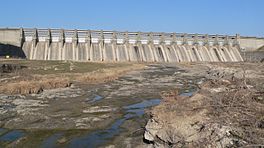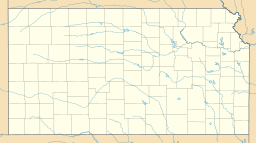Harlan County Reservoir facts for kids
Quick facts for kids Harlan County Reservoir |
|
|---|---|

Outlet structure of Harlan County Dam, seen from downstream
|
|
| Location | Harlan County, Nebraska / Phillips County, Kansas, United States |
| Coordinates | 40°04′15″N 099°12′41″W / 40.07083°N 99.21139°W |
| Type | reservoir |
| Primary inflows | Republican River |
| Primary outflows | Republican River |
| Basin countries | United States |
| Max. length | 7 mi (11 km) |
| Surface area | 13,250 acres (5,360 ha) |
| Surface elevation | 603 m (1,978 ft) |
| Settlements | Alma, Nebraska, Republican City, Nebraska |
The Harlan County Reservoir is a large lake and dam system in south-central Nebraska. A small part of it also reaches into northern Kansas. This big lake was created by the U.S. Army Corps of Engineers. They built a dam on the Republican River, which flows from Colorado all the way to Kansas.
The towns closest to the reservoir are Republican City and Alma. Republican City has places where you can buy fishing gear, rent boats, eat, and stay in cabins. Alma is right on the lake's edge when the water is at its normal level. It offers places to stay, restaurants, stores, and churches.
Contents
History of Harlan County Reservoir
Early Life and Settlements
Many Native American tribes lived in the Republican River Valley long ago. Groups like the Pawnee, Arapahoe, and Cheyenne used the land for their survival. In the 1850s, when the Nebraska Territory was formed, early settlers and trappers arrived. The rich soil near the river attracted many farmers to the area.
Native Americans warned early settlers not to build big houses too close to the river because of "big water" (floods). In 1872, Dr. John McPherson moved to the river valley. He opened stores and planned a town he called Republican. Later, when a post office was built, the town officially became Republican City. In 1881, the Burlington Railroad reached the town, making it a busy trading spot.
The Great Flood of 1935
On May 31, 1935, a huge storm hit the Republican River area. It rained 24 inches (610 mm) in one day, which is much more than the usual nine inches (229 mm) of rain the area got in a whole year! This massive flood wiped out Republican City in minutes, and about 100 people lost their lives.
The flood also caused a lot of damage to farms and roads. Nearly 10,000 cattle were lost along the Republican River Valley. Also, 300 county bridges and over 300 miles (480 km) of roads and railway were destroyed. The flood caused more than $26 million in damages.
Rebuilding and Dam Construction
After the terrible flood, the town decided to move to higher ground to stay safe. The U.S. Army Corps of Engineers then looked for the best place to build a dam. They wanted to prevent such huge floods from happening again. They chose an area between Republican City and Naponee.
Republican City was rebuilt two miles (3 km) north on higher ground in 1952. A few of the original buildings were moved. If the water level in the reservoir is low, you can sometimes see the foundations of the old buildings.
Geography of Harlan County Reservoir

The route of the Republican River
|
The Harlan County Reservoir covers about 13,250 acres (53.6 km²). It sits in the low lands of the Republican River Valley. The lake is about seven miles (11 km) from the Nebraska/Kansas border. It is nine miles (14 km) long and has about 75 miles (121 km) of shoreline.
The dam that forms the reservoir is on the Republican River, two miles (3 km) south of Republican City. The U.S. Army Corps of Engineers says the river valley got its name from the Republican Pawnee Indian tribe who lived there. The land around the lake has many thick trees and bushes, like most river bottoms. Harlan County Reservoir is the second largest lake in Nebraska.
Ecology and Wildlife
The U.S. Army Corps of Engineers manages the lake and about 17,750 acres (71.8 km²) of land around it. They also manage the Republican River near the lake. Corps staff check the dam to make sure it is safe. They work with the Kansas District Water Management to decide how much water to let out of the reservoir into the Republican River.
The Corps staff also take care of the roads, water systems, campsites, beaches, boat ramps, and picnic areas around the lake. They work with the Nebraska Game and Parks Commission to protect the natural resources of Harlan County Lake.
Fish Species in the Lake
Harlan County Lake is home to many kinds of fish. You can find walleye, white bass, wipers, catfish, crappie, and pike here. Many people also enjoy ice fishing on the reservoir when it freezes in winter.
Birds of Harlan County Reservoir
Many different birds can be seen at Harlan County Reservoir. Some of these include the common loon, black-legged kittiwake, parasitic jaeger, little blue heron, white-faced ibis, and Sabine's gull.
You can often spot Bald eagles in the late fall and winter months, especially near the western end of the lake by Alma. Many migratory birds use Harlan County Reservoir as a resting spot each year as they fly south. With lots of water and thousands of acres of green wheat and corn fields, this area is very important for ducks and geese on their long journeys.
Mammals Around the Lake
The shoreline and rivers around the reservoir support many types of mammals. Beavers and muskrats live in the muddy banks of the small creeks and streams that flow into and out of the lake. This area is perfect for them because they need small willows and trees to build their dams and homes.
The thick bushes in the river bottom are great habitat for whitetail deer. Other animals that rely on the lake's habitat for survival include field mice, moles, ground squirrels, rabbits, raccoons, opossum, skunk, badger, coyote, and bobcats.
Plants and Habitats
The main type of plant life around Harlan County Lake is mixed prairie grasses. According to the U.S. Army Corps of Engineers, these prairies have grasses like Big Bluestem, Little Bluestem, Indian grass, western wheatgrass, buffalo grass, blue grama, and switch grass.
Many areas are also covered by trees and bushes. You can find Cottonwood, ash, cedar, and maple trees all along the Republican River and other low-lying areas leading to the lake. The plants in any ecosystem are very important because they create most of the habitat for animals.
Land Management and Conservation
One challenge at Harlan County Lake has been a problem with feral hogs. These wild pigs destroy farmland and wildlife habitats. They can also spread diseases to other wild animals and farm pigs. In February 2008, the Nebraska Game and Parks and U.S. Army Corps of Engineers removed 69 feral hogs from the area. They were shot from a helicopter by a trained sharpshooter.
Over the years, a lot of the native prairie and woodland in the area has been restored. More than 300,000 trees have been planted. Also, 2,000 acres (8.1 km²) of native prairie have been replanted using money from the Nebraska Game and Parks Commission Habitat Stamp Program. These efforts help keep the natural environment healthy for all the plants and animals that live there.



